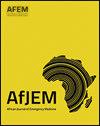Factors contributing to extended length of stay in the emergency department and potential strategies for improving patient flow in a central hospital in the Gauteng Province, South Africa
IF 1.2
4区 医学
Q3 EMERGENCY MEDICINE
引用次数: 0
Abstract
Background
Length of stay (LOS) is an integral part of inpatient care in hospitals, particularly in Emergency Departments (EDs). It is an essential performance indicator for the National Indicator Data Set in South Africa. Multiple studies have indicated a correlation between an increased LOS and worse patient outcomes in a variety of acute medical conditions. The study aims to establish the key factors of LOS in the ED at a central hospital in the Gauteng Province of South Africa.
Methodology
A cross-sectional study was conducted over seventeen months (Aug 2023 to Dec 2024) based on 2927 entries of patients admitted at the ED for more than 48 hours. No intervention was done as part of this study.
Results
The median LOS was 2.81 days (IQR: 2-3) with a minimum of 2 days and a maximum of 12 days. A regression analysis demonstrated that the most significant determinants for prolonged LOS were gender and disease group of boarded patients awaiting ward transfer.Significant differences (p < 0.001) in the LOS between clinical disciplines were noted, with medical (45%) and surgical departments (46%) accounting for most boarding patients compared to all other clinical disciplines.
Conclusions
Data demonstrated that 80% of patients in the ED wait an average of 3 days before transfer into the wards. This extended ALOS in the ED has consequences for patient outcomes and the quality of healthcare provided. Based on the findings of this study, strategies to improve patient flow are essential in facilitating timeous discharge from wards and to prioritise the forward flow of patients waiting in ED.
南非豪登省一家中心医院急诊住院时间延长的因素及改善病人流动的潜在策略
住院时间(LOS)是医院住院治疗的重要组成部分,特别是在急诊科(EDs)。它是南非国家指标数据集的一个重要绩效指标。多项研究表明,在各种急性医疗状况下,LOS增加与患者预后恶化之间存在相关性。本研究的目的是在南非豪登省的一家中心医院的急诊科建立LOS的关键因素。方法对2927例在急诊科住院时间超过48小时的患者进行为期17个月(2023年8月至2024年12月)的横断面研究。本研究没有进行干预。结果中位生存期(LOS)为2.81天(IQR: 2-3),最短2天,最长12天。回归分析表明,等待转病房的住院患者的性别和疾病组是延长LOS的最重要决定因素。注意到临床学科之间的LOS存在显著差异(p < 0.001),与所有其他临床学科相比,内科(45%)和外科(46%)占大多数寄宿患者。结论数据显示,80%的急诊科患者平均等待3天才能转入病房。这种在急诊科扩展的ALOS对患者的治疗结果和所提供的医疗保健质量产生了影响。基于这项研究的发现,改善病人流量的策略对于促进及时出院和优先安排在急诊科等待的病人向前流动至关重要。
本文章由计算机程序翻译,如有差异,请以英文原文为准。
求助全文
约1分钟内获得全文
求助全文
来源期刊

African Journal of Emergency Medicine
EMERGENCY MEDICINE-
CiteScore
2.40
自引率
7.70%
发文量
78
审稿时长
85 days
 求助内容:
求助内容: 应助结果提醒方式:
应助结果提醒方式:


